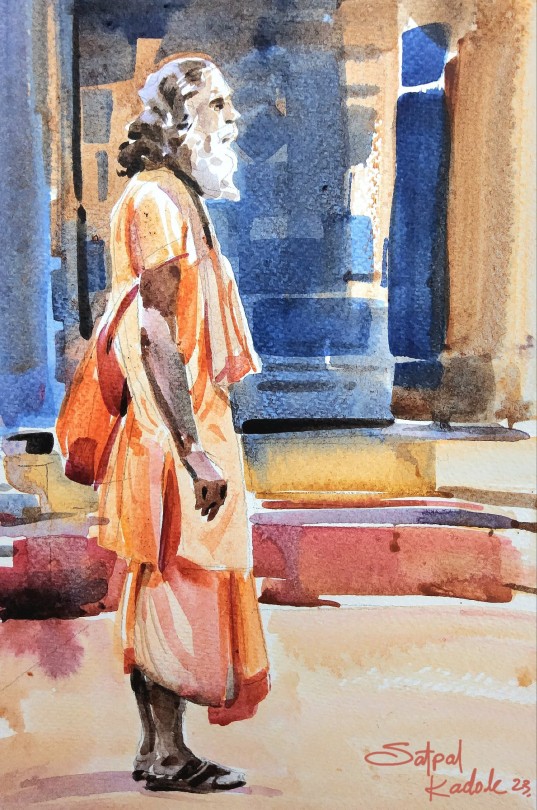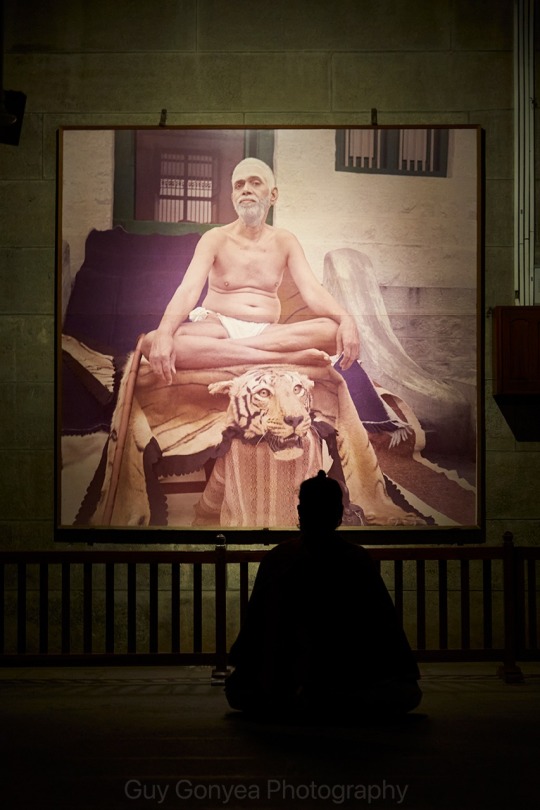#Sadhu
Text

Nailed.
#yoga#torturedevice#spikes#sadhuboard#sadhu#nailstanding#nails#nailboard#nailbeds#mindoverbody#metalnails#headtotoe#girlinbikini#fullbody#fitbod#bikinis#bikinimodel#bikinigirl#bikinibody#bedofnails
90 notes
·
View notes
Text

"Sadhu" watercolor painting,
8 notes
·
View notes
Text

Kamal Rao, Sadhu with Shank (2015)
* * *
“He is the real Sadhu, who can reveal the form of the Formless to the vision of these eyes:
Who teaches the simple way of attaining Him, that is other than rites or ceremonies:
Who does not make you close the doors, and hold the breath, and renounce the world:
Who makes you perceive the Supreme Spirit wherever the mind attaches itself:
Who teaches you to be still in the midst of all your activities.
Ever immersed in bliss, having no fear in his mind, he keeps the spirit of union in the midst of all enjoyments.
The infinite dwelling of the Infinite Being is everywhere: in earth, water, sky, and air:
Firm as the thunderbolt, the seat of the seeker is established above the void.
He who is within is without: I see Him and none else.”
— Kabir
#Kamal Rao#Sadhu with Shank#Sadhu#Art#Beauty#Painting#Poetry#Wisdom#Kabir#Infinite Being#Bliss#Supreme Spirit
7 notes
·
View notes
Text
The Aghori are a mystical Hindu sect renowned for their extreme practices. They have long been associated with stories of cannibalism and black magic, but how true are they?
30 notes
·
View notes
Text
How much things goes in theory as some people form a collective spectrum of thought and forget about the actuality which over strikes all the sayings and changes occurred in the time being, Few things around the world of divine I feel..
There is a lot of issues to see what is the truth, like if ask even one of you introduce yourself..you might begin it with what have you been, done and accumulated all these years..
As if I remove this you would be sacred and afraid to the actuality of who you are..
Here is where divination comes in picture so a human can scale his understanding beyond the ability to experience things for real then bloating in words..
Few things which are misinterpreted by the people in general ;
1. Astrology : Foot Notes to your existence
2. Tarot and Decks : Current Energy
3. Witch Craft : Rituals to Craft Energies
4. Prayers and Traditions : Devotion through Expression
5. Psychic : Accessing the Universe and World Insights
6. Black Magic : Storing Energies and Tying them up
7. Yogis : Bodily ready to attain spiritual enlightenment
8. Sadhus/Rishis : Preserve the energy in the time being to enlighten others
9. Sansari : Following the nature of the world and living accordingly
10.Brahmachari : Abandoning the Rules of World and to seek inner solitude as an individual
11. Bhakti : Deep Allocated Faith
Note : This is what I see through, the reality behind of named and label human beings behind their spiritual journey because they have misunderstood for being, god alike, demon like, fraudulent and much more, we all are human defect fixating our brains on loop holes and forgetting what we are digging for ourselves ahead, so it is general that
'One in five and two in ten' are spiritually awakened then humanely alarmed ! - S
#divination#divine guidance#sadhu#astrology#astro observations#pyschic#prayers#yogis#tarot and astrology#witchcore#bhakti#faith#god#energy#intution#spiritualvision#Spirituality#Mindfulness#Enlightenment#Awakening#Meditation#Consciousness#InnerPeace#Yoga#Zen#SelfDiscovery
7 notes
·
View notes
Text

A Saadu priest engages the camera with a penetrating stare near Srinagar, Kashmir
Ric Ergenbright
18 notes
·
View notes
Photo

Prime Mate by Beloveful
5 notes
·
View notes
Text

Happy Sadhu
23 notes
·
View notes
Photo

Sadhu on a bed of nails (casually reading a book!) - 1880s
https://imgur.com/r/oldindia/8u7B5JS
35 notes
·
View notes
Photo

🔱 Om Namo Bhagavathe Sri ArunachalaRamanaya 🔱
Photo by Guy Gonyea
🕉️
The Paramount Importance of Self Attention, by Sri Sadhu Om, As recorded by Michael James
Part Four - Mountain Path: January – March 2013 - Excerpt
Note of 2nd January 1978
🕉️
Sadhu Om: Once we have wholeheartedly taken Bhagavan to be our guru, we have no need to worry: we are like the child in its mother's lap. Of course, we cannot expect Bhagavan to choose us as his disciples, because in his view there are no others, so it is for us to decide that he is our only guru and protector.
Once we have wholeheartedly decided this, then we are truly having association or satsanga with him. This is really the satsanga that he refers to in the first five verses of Ulladu Nαrpadu Anubandham [Reality In Forty Verses - Supplement]. Once we enjoy this satsanga, he will be working from within and without. From outside he will shape our physical circumstances suitably, and from inside he will work deep within our cittam (mind, mental activities), where he will root out our vāsanās by burning, drying, churning out or dealing with them in whatever other way is most appropriate. We may not see any changes, of course, because the mind is not a suitable instrument for gauging its own development.
The influence of his silence is of course dependent upon [the receptivity of] us, the receiver set. As he says in the twelfth paragraph Nan Yar? - Who am I?, we must unfailingly follow the path shown by the guru. We must be sincere in our love for him. He says that he is self-shining in each one of us as 'I', so if we really love him, we will naturally and happily attend to this 'I'. When we are thus in his hands, he will make us do whatever is necessary. When we should attend to self, he will make us do so, and when we need some other experiences, he will provide them also.
If Bhagavan was truly a fit guru (our real self) when he was appearing as a body, then he must also be a fit guru now. But then he was with all his (Brahman's) five aspects, sat-cit-ānanda-nāma-rūpa [being-consciousness-bliss and name-and-form], whereas he is now without nāma-rūpa, his false aspects, and hence he shines unimpeded as pure sat-cit-ānanda. Therefore his power is now infinite. He always used to say that his body was veiling his true nature, and that those that took that body to be guru would be disappointed. Now his body has gone, he has left us with no outward form to cling to, so we have no alternative but to accept that 'I am' alone is the guru. I have found that many disciples who have come to him after the passing of his body are more sincere and have clearer understanding than most of those who came earlier [because they were fixated just on his physical form].
He now saves us from mistaking him to be the body, so what advantage would we gain from going to other bodies who are reputed to be great mahātmas? He has said that the greatest mahātma is within, so why not forget those other mahātmas and abide peacefully as this mahātma (our real self)?
Using the yardstick given to us by Bhagavan, we can now see that any would-be guru who conducts classes and flies around the world, thinking that he is guiding others, is not a real guru, because the guru does not see any ignorant jivas to guide. Bhagavan never attempted to guide anyone, but just kept quiet, and it was always a great wonder to him when people came to him saying, 'Bhagavan, I do not know myself, so please show the way to self'. What could he reply? He could only counter question: 'Who does not know whose self? Who is this I?'
Α mantra is a set of sacred syllables, and the word literally means 'that which protects when meditated on', coming from the same root as manas [mind] and manana [meditation or cogitation]'. Who is to be protected? The ego! A name of God will at least lead us to God, but a mantra will only protect us (our ego, mind or individuality) from God. There has been so much talk in India about mantras that nowadays people are not satisfied unless they are given a mantra. However, mantras are only for worldly things, so Bhagavan and Ramakrishna never initiated anyone with mantras.
Bhagavan's instruction concerning mantra-japa was that we should watch the source from which the sound of the mantra rises. What did he mean? Since the sound rises only from oneself, who repeats the mantra, he meant that we should ignore the mantra and instead cling fast to self-attention.
The mind must be made one-pointed so that it will cling to one thing alone, but for that it is not necessary to practise concentration on any second or third person, such as our breathing, a mantra or a form of God. We can just as well start our concentration practice by attending to the first person, 'I'. If we wish to learn to cycle in order to cycle to Tirukoilur, it is not necessary to practise in some open space here. Why not start our practice on the road to Tirukoilur? Likewise, since self is our goal, why not start by attending to self?
Some people may say that attending to 'I' is more difficult than attending to other things, but how can they prove their claim? In part one of The Path of Sri Ramana I have explained what is difficult and what is easy. Whatever you try to attend to, whenever your attention wanders, you must draw it back to its target, and this is easy to do whether that target is 'I' or some object. Attending to the first person is the direct means, and attending to anything else is in no way any easier. Indeed, practising concentration on any object will only increase the outgoing tendency of the mind, and will thus hinder us when we turn towards self.
In Nan Yar? - Who am I? [Paragraph 8], Bhagavan says, '... when the body dies, the mind seizes and takes the prāna away'. This simply means that when the mind subsides into its source, the tendency or habit of breathing also subsides. Then as soon as the mind rises again, projecting a new body, the function of breathing restarts automatically and immediately. Whenever there is body-consciousness, there is breathing. Breathing is an ingrained habit of the mind, and if we try to see how breathing starts, the mind subsides. This is another clue for self-attention [because what breathing starts from is only ourself].
Scientists talk of an involuntary nervous system, but there is no such thing. If they looked to see how these 'involuntary' functions start, they would understand that all physical functions are volition-driven actions of the mind, so they can be controlled if they are scrutinized by a sharp and refined mind.
Bhagavan used to say that dream is the activity of a halfconfused mind, and waking is the activity of a fully confused mind. In fact, the mind itself is confusion. We have so many confused beliefs — that we are born, that we have a past and a future, and so on — but if we really consider all such things, we will see that they are known only after we come into existence as this mind. If we carefully scrutinise the mind to see how and when all these thoughts arise, we will find that 'I am' alone is always shining. The past and future are only thoughts existing now, in the present moment.
Therefore I am a pukka atheist. I always say: don't believe what you don't know! The only thing we know directly and for certain is 'I am'. We know of our birth only by hearing about it from others, but we know these 'others' only after knowing ourself. Our present knowledge of the past is only ideas obtained from memory or external sources, which are second or third persons, but we know second and third persons only after knowing the first person. Our belief in the future also relies upon a second or third person, namely the inferring faculty of our intellect. Even our experiences of the present moment are known only indirectly through our mind and senses. Hence, all knowledge is merely a reflection of our original knowledge, 'I am'. It is all a flimsy reflection of our own self-awareness, and seems real and substantial only because of our mental confusion, which will disappear if we keenly scrutinise the first person or the present moment.
In Nan Yar? - Who am I?, [Paragraph 12], Bhagavan says that those who earn the gracious glance of the guru will surely be saved, but the guru's glance is not just the glance of his physical eyes. If we wish to know if someone is looking at us, we must look at them, and since self is the guru, we must turn selfward to see if self is looking at us. Indeed the guru is always looking at us, so in order to be saved we only have to attend to him, who shines as 'I'.
Many people say to me, 'This self-enquiry is difficult, so please tell us what self-surrender is', but in Nan Var? [Paragraph 13] Bhagavan says that self-attention alone is self-surrender:
Being completely absorbed in ātma-nishtha [self-abidance], giving not even the slightest room to the rising of any thought other than ātma-cintana [self-contemplation], is giving ourself to God.
When people ask me what meditation Bhagavan taught, I reply that meditation means thinking, but Bhagavan instructed us not to think — to stop meditating. This is what he teaches us in the first mangalam verse of Ulladu Narpadu - Reality In Forty Verses:
... Since the existing reality exists without thought in the heart, who can [or how to] meditate on [that] existing reality, which is called 'heart'? Being as it is in the heart alone is 'meditating'. Experience [thus].
The aim of all yogas is to make the mind one-pointed, so that it has the strength to abide firmly in its source. This is why I always recommend people to stick to one guru and wholeheartedly follow his teaching. Even if the guru is a bogus one, so long as your guru-bhakti is sincere, your onepointedness of mind will soon give you the clarity to see that he is bogus. This is why Bhagavan criticised people going to many mahātmas. For example, in verse 121 of Guru Vacaka Kovai he says:
You who desire to see with wonder that mahātma and this mahātma! If you investigate and experience the nature of your own mahātma [great self] within you, [you will see that] every mahātma is only [that] one [your own self].
If you meet one real mahātma, he will teach you that the ātma in you is the same as the ātma in all mahātmas, and that it is therefore futile to go to any other mahātmas. Onepointed guru-bhakti is essential for the earnest practice of self-attention.
Another clue for self-attention is to try to see exactly when, how and from what thought arises. Such attention will automatically make the mind subside.
Thought rises only when there is self-negligence (pramāda), attention to any thing other than self.
🔱 🔱 🔱 🔱 🔱 🔱
#Bhagavan Sri Ramana Maharshi#the paramount importance of self-attention#Sadhu Om#Michael James#jnani#mahatma#sadhu#sage's eyes#eye of wisdom#eye of truth#satsang#sat-sanga#association with sages#sadguru#bhakti#devotion#love#association with the Self#oneness of Self#non-duality#UNAfirstfiveverses#NY §12#EV v.4#sat-cit-ananda-nama-rupa#NY §8#NY §13#UN v.Benedictory#gvk v.121#self-attention#self-iinvestigation
13 notes
·
View notes
Text

I know i promised some king Julien and Karl tribute for their amazing wedding, congratulations again, but Pancho here went to India for a spiritual journey. He visited ashrams and hung out with sadhus and actually became one himself🤣I can’t even with this dude…this is Pancho shivaite sadhu, a holy man (or should I say holy lemur) smoking charas with a chillum, getting ready for his meditation and sadhana in Parvati valley in a paradise idealized ganja field at Himalaya’s foothills . Now he is a lord Shiva devotee as you can see by the tripundra on his forehead… aum namah Shivaya🕉❤️🌈🇮🇳
I promise next thing will be king Julien and Karl ❤️
… I am honestly living for this…. Bombolenath!
Om shanti
#ahkj pancho#sadhu#Shiva#Parvati#himachal pradesh#ganjafield#chillum and chill#himalaya#om namah shivay#ahkj fanart#what have you become#charas#hashish
24 notes
·
View notes
Photo

Prayagraj, India
A sadhu, or holy man, waits to be allotted a temporary tent for the Magh Mela festival
Photograph: Sanjay Kanojia/AFP/Getty Images
#sanjay kanojia#photographer#afp via getty images#prayagraj#india#culture#sadhu#holy man#magh mela festival
3 notes
·
View notes
Text
Almost all Hindu gods have 2 sides:
Shanthi Swaroopa and Tantric Swaroopa 🙏🏼
Shanthi Swaroop is to bless and Tantric swaroop for protection.
#hindu#hinduism#hindu culture#hindustan#hindugods#desiblr#hindu mythology#desi stuff#196#tantrik#sadhu#tantra
5 notes
·
View notes


